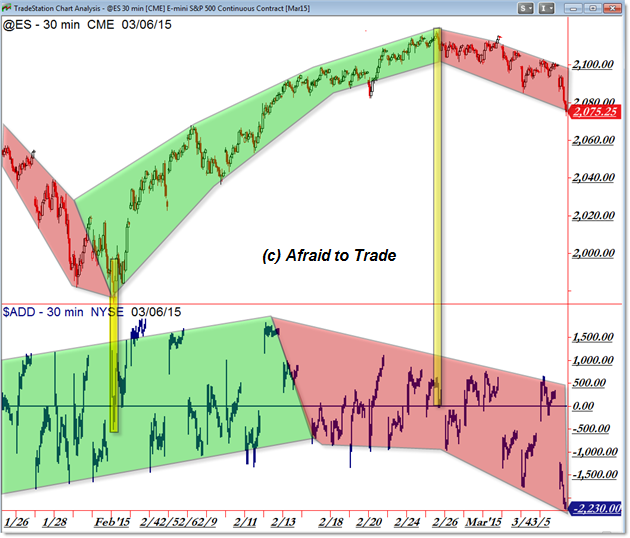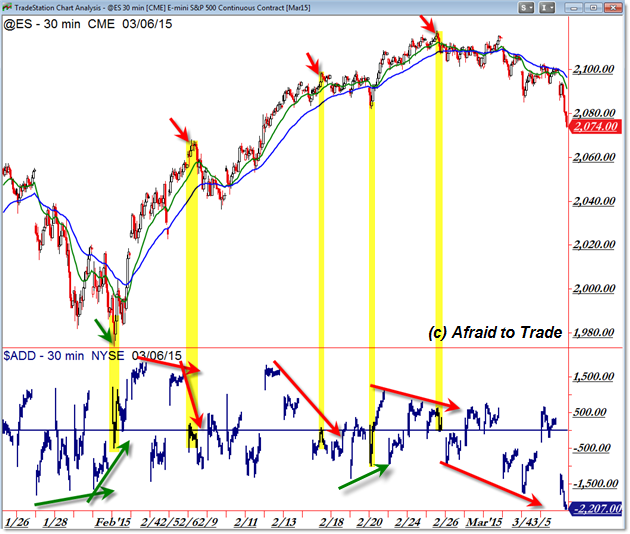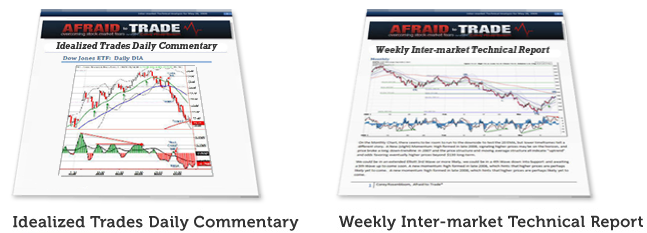Returning to a World Where Breadth Divergences Matter
It’s easy to get caught up in thinking “The market will go up forever!” when in reality, the rules of gravity have not been permanently amended.
What goes up must come down, and trends (even intraday ones) must eventually retrace.
Divergences are great warning signs that a mature trend may soon reverse.
Let’s revisit this lesson as we plan and trade today’s sell-off in the context of a world where divergences matter:

We’re charting the @ES Futures which could just as easily be the S&P 500 Index or the SPY ETF.
The main idea is to plot price – in this case on the intraday (30-min) frame – with something else like internals, momentum, or volume.
We’re seeing NYSE Breadth or the Number of Advancing Issues Minus the Number of Declining Issues.
Breadth is helpful for assessing internal strength – or weakness – of a price movement.
Internals (the ‘guts’ of the market) are often strongest (making new highs) at the beginning of an intraday trend and weakest – diverging – as the mature trend nears a reversal.
I color-coded the chart above to make it simple to see the trend in price overlaid with the trend in Breadth.
Notice how Breadth was strongest at the beginning of the rally in early February and then flashed another peak on February 12th – well ahead of the February 25th short-term market top.
From there, Breadth has trended lower in a down-channel in addition to creating a negative divergence (price making a new high while Breadth is not making a new indicator high).
We’re seeing the resolution so far with price trading down away from the 2,110 level toward the current 2,075 level and potentially lower than that.
Here’s a more sophisticated view at the broader and shorter-term divergences that have developed:

Each highlight reflects a positive (green) or negative (red) divergence with Breadth and price.
These look clearer on a lower timeframe chart but we can still understand the quick price action with Breadth.
The fact that Breadth is making new lows with price right now – in a downtrend – suggests that sellers may continue to push the market lower down away from the 2,100 level.
Closely monitor Breadth – a key Market Internal – with Price and use them in conjunction to plan possible reversals and trading opportunities.
Follow along with members of the Daily Commentary and Idealized Trades summaries for real-time updates and additional trade planning.
Corey Rosenbloom, CMT
Afraid to Trade.com
Follow Corey on Twitter: http://twitter.com/afraidtotrade
Corey’s book The Complete Trading Course (Wiley Finance) is now available along with the newly released Profiting from the Life Cycle of a Stock Trend presentation (also from Wiley).


There are not too many people who use this technique since there is skill required for this and I don’t think there are many who are good enough to do this. I was never good enough but after practicing so much with OctaFX’s wonderful demo account, I am able to learn it well and why I say wonderful demo account is that here I am able to trade just like real account due to swift server speed as compare to other brokers which never rate demo.
Yeah sometimes it happens and we feel like that only, but as we know there is always some pull back or reversal going to happen, if we are not able to manage that then we could be in trouble. I am working with OctaFX broker and with them, I can always do thing nicely and that’s to do with their top notch service which includes low spreads from 0.2 pips, high leverage up to 1.500 while there is also daily updates!